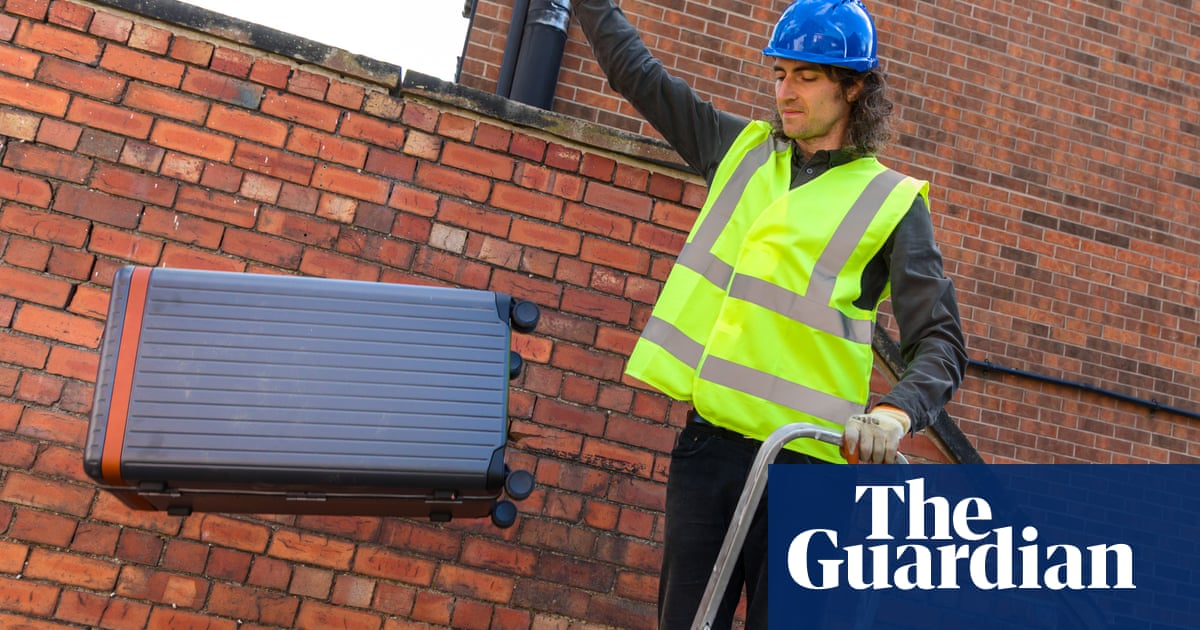Asuitcase dies not with a crash, but with a soft, tremulous thud. I learned this first-hand as I dropped luggage repeatedly from a stepladder on my driveway, all in the name ofour best suitcases group test.
The Filter team and its writers think carefully about how to test each type of product before we embark on a review. Suitcases are often marketed (but seldom rated) on their toughness, so we decided to add drop-testing to our approach, along with conventional criteria, such as internal organisation and finish. Anyone can tell you why they think a suitcase is nice, but we wanted to see how well each option might endure.
And so, one fair May morning, I put on my best baggage handler cosplay (hi-vis vest; gloves; boots; possibly ill-chosen hard hat) and wheeled eight fabulous suitcases on to my driveway. They looked unsuspecting in a line against the garden wall.
Photographer Christian Hopewell and I discussed the plan over coffee. I would pack each suitcase with baggage (my laundry!), before carrying it up a stepladder and dropping it three times – on to its top, front and side. We’d assess the damage to each suitcase after the third drop.
I took an impish delight in the testing. Moving each case to the appointed angle required some elaborate flicks of the wrist, especially as my arm grew tired from hauling the luggage and holding it aloft. The suitcases thudded to the ground, sometimes sustaining scuffs, scratches and even cracks, but usually holding up impressively. A few passersby peered quizzically at the yellow-vested man and his deteriorating collection of luggage (in fact, one of those passersby ended up rehoming a suitcase that was too damaged for resale – the rest were donated to the charityCat Action Trust 1977). My driveway had become a suitcase-testing runway.
Even though it gave ultra-hardy luggage like theAwayandHorizn Studiosa chance to excel, drop-testing suitcases might seem like overkill. If you travel by train, sea or road, it’s unlikely that your case will ever fall from such a great height (and that’s one of several motivations to choose these eco-friendlier modes of transport when you can).
However, the reality is that bad things do happen to good suitcases – notably when they’re used as hold luggage during air travel. While researching for this article, I was shocked to learn how hard baggage handlers are required to work. One airport worker interviewed by the Guardian said that the average baggage handler has to load about 150 bags within 40 minutes, several times a shift. It would only be human to handle some of those heavy suitcases roughly, or even drop them.
I should point out that some of my favourite suitcases, pre-drop testing (such as theIt LegionandAntler Icon), sustained more damage than others when dropped. If you travel infrequently or avoid air travel, you might not need a super-tough case. You could pick one with a softer finish and a lower price instead – just don’t drop it from a ladder.
The best camping mattresses and sleeping mats for every type of adventure, tested
From stick-on tiles to bookshelves: nine easy ways to update your rental home on a budget
Mid-strength drinks are having a moment. Here are 10 of the best lower-ABV beverages
‘They should be tracked down and reported’: the best (and worst) supermarket hummus tasted and rated by Honey & Co
The best eye creams: 10 favourites for banishing bags, puffiness and fine lines – tested
Many new parents struggle to stick to any kind of routine, let alone keep up their outdoorsy pre-baby lifestyles. However, some bits ofkit can genuinely help get your kids outdoors. Paddy Maddison (who has a two-year-old) spoke to parents to get their recommendations, which range froma £12 puddle suitto get them playing in the rain toa decent backpack for hikingand anelectric cargo bikesimply for dragging a reluctant toddler uphill.
Monica HorridgeDeputy editor, the Filter
Sign up toThe Filter
Get the best shopping advice from the Filter team straight to your inbox. The Guardian’s journalism is independent. We will earn a commission if you buy something through an affiliate link.
after newsletter promotion
Since we first published our roundup ofthe best coffee machines, our resident expert, Sasha Muller, hasn’t stopped testing new machines to make sure we’re giving the best recommendations. His latest edit includesa manual espresso machine for just £89.99(no, that’s not a typo).
Calling all teachers: as the end of the school year approaches, what’s the best gift you’ve ever received from a pupil or parent, one that went beyond wine or chocolates? And parents of school kids, what’s the best present you’ve ever bought a much-loved teacher, one that might have brought a tear to their eye? Let us know by replying to this newsletter or emailing us atthefilter@theguardian.com.
